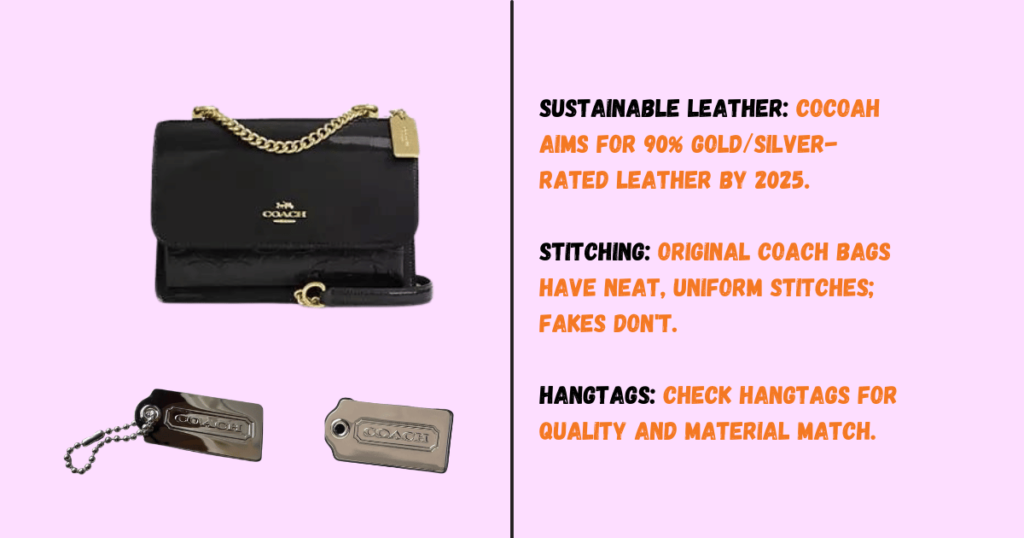Essential Tips to Identify an Authentic Coach Bag and Avoid Counterfeits
In the world of luxury handbags, Coach has carved out a prestigious niche for itself. However, with the brand’s growing popularity comes a rise in counterfeit products.
These knockoffs are often so convincing that even seasoned fashionistas might have difficulty telling them apart from the real deal.
In this guide, we’ll delve into the key differences between authentic Coach bags and their imitations, ensuring you always get what you pay for.
Why It’s Important to Spot a Fake Coach Bag
Before we dive into the details, it’s important to understand why distinguishing a genuine Coach bag from a fake one is crucial.
Not only do counterfeit bags lack the quality and durability of the real thing, but purchasing them also supports illegal activities and undermines the craftsmanship that goes into creating authentic luxury items.
Moreover, you can often find genuine Coach bags at a reasonable price at outlets, so there’s no need to settle for a fake.
The Serial Number: A Key Identifier
One of the first things to look for when verifying the authenticity of a Coach bag is the serial number.
Genuine Coach bags always feature a serial number that begins with “No.” followed by four numbers and a dash.
The paragraph above the serial number, found on the creed patch inside the bag, should also be in all capital letters. Be wary of any bag that has crooked or off-center text, as Coach maintains strict quality control, and such mistakes are unlikely to pass inspection.
Unlocking the Secrets of Coach Serial Number Codes
Stitching: The Devil is in the Details
When inspecting a Coach bag, pay close attention to the stitching. Authentic Coach bags are known for their precise, uniform stitching, where each stitch follows a straight line and is of consistent length.
If you notice sloppy, uneven stitching or over-stitched edges, it’s likely a fake. The craftsmanship of a genuine Coach bag is one of its hallmarks, and poor stitching is a clear sign of a knockoff.
The Zipper: Smooth and Steady
The zippers on a Coach bag can also tell you a lot about its authenticity. Most real Coach bags feature YKK zippers, which are known for their durability and smooth operation.
If the zipper feels rough or you can’t find the “YKK” engraving, proceed with caution. While not all Coach bags use YKK zippers, they are prevalent enough that their absence might signal a problem. A smooth, easy-to-use zipper is another indication of a well-made, authentic product.
The Logo: Font and Alignment Matter
The Coach logo is another feature that counterfeiters often get wrong. Authentic Coach logos have a very specific font; for example, the “A” in “COACH” always comes to a precise point, never rounded.
Additionally, the “C” in the logo should be perfectly aligned, both horizontally and vertically. Any irregularities in the font or logo placement, especially on the hang tag, are red flags that the bag might be a fake.
Lining and Material: The Interior Matters
Coach never produces bags with the signature “CC” pattern on both the exterior and the lining. If the outside of the bag features the “CC” pattern, the lining will be plain. Conversely, a bag with a “CC” patterned lining will have a plain exterior.
Furthermore, the quality of the lining should reflect the overall quality of the bag – high-quality fabric, neat stitching, and no signs of wear or tear. The materials used in authentic Coach bags are premium, ensuring the bag feels luxurious and durable.
Hardware: Weight and Finish Tell the Tale
The hardware on an authentic Coach bag is another indicator of its genuineness. Coach often uses brass or nickel for their bag hardware, which is slightly heavier and has a muted finish compared to the shiny, lightweight hardware found on fakes. Additionally, the “C” logo should be clearly visible and well-crafted. If the hardware feels flimsy or too shiny, you might be dealing with a counterfeit.
The Hang Tag: Small but Significant
Each Coach bag has a hang tag made from the same leather as the bag. This tag should feel thick and match the bag’s material in both texture and quality.
A flimsy, mismatched hang tag is often a sign of a fake. It’s also a good idea to keep the hang tag even if you remove it from the bag, as it can help authenticate the bag later on.
Final Tips: Trust Your Source
Even with all these tips in mind, the best way to ensure you’re getting an authentic Coach bag is to purchase it from a trusted source.
Coach stores, official outlets, and authorized department stores are your safest bets. If you’re buying secondhand, thoroughly research the seller and ask for a certificate of authenticity.
Conclusion
Stay Savvy, Stay Stylish
Spotting a fake Coach bag can be challenging, but with careful inspection and attention to detail, it’s possible to differentiate between a counterfeit and the real deal.
By following the guidelines in this article, you can confidently shop for your next luxury handbag and enjoy the timeless elegance that comes with owning an authentic Coach product.





